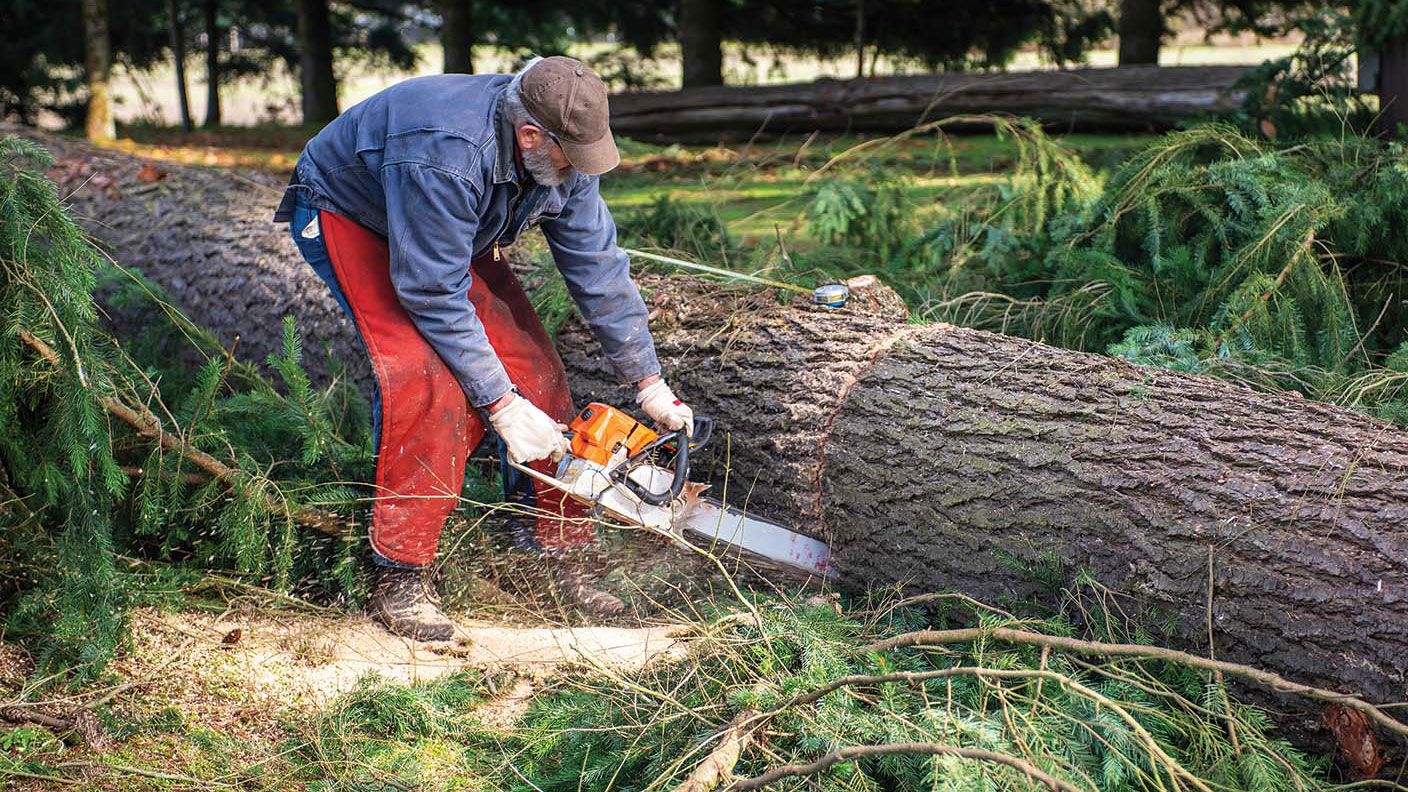How to invest in lumber, whichever way the market goes
Wood plays a key role in US housing. Slow growth has hurt prices – but not for long, says David J. Stevenson.

We are all familiar with the classic commodities such as oil, copper and precious metals. However, US lumber – known as timber in the UK, although Americans draw a distinction between the two – isn’t such an obvious choice for those looking to invest in basic materials. Yet it has shown over the last couple of years that it can rise – and fall – very quickly.
Between 1992 and early 2020, apart from a couple of temporary surges, US lumber traded between $200 and $430 per 1,000 board feet (this is the standard measurement gauge – a unit of volume equivalent to a board one inch thick, one foot wide and one foot long, or 144 cubic inches in total volume). Then came the Covid-19 fallout. From a low of around $260 per 1,000 board feet at the start of April 2020, the price soared to $1,700 in just over a year. After several intervening ups and downs, it has now come down to about $600.
What sparked the take off and subsequent volatility? And what happens now? To answer these questions, we need to look closely at the fundamentals.
MoneyWeek
Subscribe to MoneyWeek today and get your first six magazine issues absolutely FREE

Sign up to Money Morning
Don't miss the latest investment and personal finances news, market analysis, plus money-saving tips with our free twice-daily newsletter
Don't miss the latest investment and personal finances news, market analysis, plus money-saving tips with our free twice-daily newsletter
Driven by housing
First, what exactly is lumber? In the US, the term refers to sawn wood only, while timber means felled trees with the bark still on (and even sometimes trees that have not yet been cut down). Lumber is big business.
Measured by revenue, the lumber wholesaling industry is worth around $200bn, according to data from industry monitor IBISWorld (clearly this value depends on the lumber price). On average, the US market has grown by 14% a year between 2017 and 2022.
America’s lumber industry has three sub-sections: logging, sawmill and wood panel. The first two are largely self-explanatory, while the wood-panelling industry manufactures a variety of products such as plywood, veneer, trusses, I-joists, oriented strand board and particleboard. Most of these products are employed in construction. Plywood and veneer are probably familiar to you. Oriented strand board is widely used for sheathing (a building’s wooden outer casing before brickwork is installed) and subflooring. Particleboard features mainly in furniture making. Trusses provide structural support for flooring and roofing. I-joists have great strength compared with their size and weight, so applications include shouldering heavy loads.
As that list makes clear, residential property is a crucial demand driver for lumber and has played a major role in recent price volatility. In 2006, US housing starts hit an all-time high of 2.5 million units after a steady improvement following the 1990 recession. Then the global financial crisis (GFC), which began with a wave of mortgage defaults, prompted a stunning 80% plunge in starts. This was devastating for lumber demand and led to the closure of several US mills.
After those turbulent times, the US saw a progressive recovery in housing starts to roughly 1.6 million at the start of 2020. That’s when Covid-19 hit, triggering a sharp drop in starts to below one million.
However, this decline wasn’t a carbon copy of the GFC. The spate of lockdowns hugely increased the number of people working from home. In addition, buyers ramped up residential real-estate buying, spurred by record-low mortgage rates, and embarked on more home renovation. Demand for single-family houses was strong. And with existing dwellings in short supply, all that extra buying filtered through into higher house prices and more housebuilding. Thus the requirement for more lumber products grew sharply.
Supply shortfalls
Supply was not able to keep pace. The initial response by sawmills to Covid-19 restrictions had been to furlough employees and curb output. By April 2020, US wood production had declined by 15% compared with 2019 levels. As falling supply coincided with surging demand, the lumber price soared more than sixfold from the beginning of April 2020 to May 2021.
“From 2020 to the first half of 2021, it really was an issue of production at the mill,” says Dustin Jalbert of Fastmarkets RISI in Fortune. “There just wasn’t enough sawmill output, not enough wood products output, to meet demand.”
The problem about this surge was that buyers reacted by opting for alternatives, such as composite materials, and this punctured the lumber-price bubble. “The culprit [of the correction] was the demand side,” Stinson Dean of Deacon Lumber told Fortune magazine in September 2021. Homebuilders felt the “full brunt” of rising lumber prices “and completely hit the brakes”. Within three months, lumber had toppled back to the region of $500 per 1,000 board feet.
However, this wasn’t the end of the volatility. Lumber had shown how it could respond to a demand shock. In November last year it also experienced significant supply-side interruption. The US only produces enough softwood lumber to satisfy about 70% of its total requirements. Almost all the rest comes from Canada. Last November, record rainfall in lumber-producing south-western British Columbia and the US Pacific Northwest disrupted logging supplies. By early March this year, lumber prices reached nearly $1,500 per 1,000 board feet again.
However, since then prices have again plunged – by some 60% – due to a different kind of demand: shock. Rising interest and mortgage rates have spurred concerns about demand for housing. US existing home sales declined – for a third consecutive month – by 2.4% in April 2022 to a seasonally adjusted annual rate of 5.61 million. That was the lowest level since June 2020. Thus builders have begun to retrench. Single-family home completions, starts and building permits all dropped in April, according to the Census Bureau.
As a result, lumber orders have slowed and wood is piling up at mills, lumber-pricing service Random Lengths tells The Wall Street Journal. “Triple-digit discounts [have become] the rule rather than the exception.” Only 12% of monthly building-product survey respondents had slightly low to very tight lumber and wood panels inventories in April, down from 61% a year earlier, says John Burns Real Estate Consulting.
Canfor, one of Canada’s biggest lumber producers, said its Canadian sawmills have been operating at about 80% of production capacity since late March. “Global supply challenges are continuing to significantly limit our ability to transport products to our customers, and our inventory levels remain very high,” says CEO Don Kayne in The Wall Street Journal.
Long-term housing crunch
So where do US housing starts and the lumber price go from here? For the former, “it looks like more declines are imminent in the upcoming months, and we’ll probably return to pre-pandemic home sales activity after the remarkable surge over the past two years”, says National Association of Realtors’ chief economist Lawrence Yun. What’s more, fears of a US recession in the second half of 2022 are mounting. “It is our belief that we are past peak demand, and this commodity bull wave is over,” Kyle Little, chief operating officer at Sherwood Lumber, tells Fortune magazine. “It is now moving to its next cycle. Lack of clarity on future demand is putting significant pressure on the commodity price down the road.”
On this basis, the outlook for lumber isn’t exciting. However, the US still has a housing shortage. “There is less housing available for rent and sale than at any time in 30 years, and things are only getting worse,” said Moody’s Analytics last year. “The annual supply of new housing units is running an estimated 100,000 below new housing demand, creating the largest shortfall in nearly a half century, equal to almost a year of new construction at its current pace.”
Last month, US president Joe Biden announced plans to address the country’s housing shortfall, with a goal of closing the construction gap within five years. This could take time to come to fruition, especially if the economy slows down, but over the medium and longer term, strong US housing demand is likely to be supportive for lumber prices. Indeed, if the coming downturn leads supply to be cut sharply again, it may even increase the chance that lumber prices once again repeat their 2021 surge as activity picks up.
A bullish play on lumber – and a bearish bet, too
Despite the bearish sentiment in both the lumber industry and the US stockmarket, stocks within the sector have generally held up well. Of course, this could mean that most are due for a pullback. So here are two stock selections to cover both the potential downside and upside in lumber prices.
LL Flooring (NYSE: LL) is one of America’s leading speciality retailers of hard-surface flooring, with more than 430 stores nationwide. The company sells more than 500 varieties of hard-surface floors, plus a range of flooring enhancements and accessories. The fact that it requires lumber as an input to many of its products means it should benefit from lower prices.
At a current price of $9.80, the shares have fallen 70% since they peaked at about $33.70 towards the end of 2020. The market cap is now less than $300m. Analysts’ average earnings per share (EPS) forecasts for 2022, 2023 and 2024 are $1.12, $1.38 and $1.68, according to MarketWatch data. This would put the stock on a price/earnings (p/e) ratio of 8.75 this year, falling in subsequent years. There’s almost no long-term net debt. The stock does not pay a dividend.
The obvious way to bet on a rebound in lumber prices is through producers. Many US-listed firms in this sector use a real estate investment trust (Reit) structure for tax purposes. (Reits don’t pay corporate tax on their profits as long as they pay out at least 90% of their profits as dividends.)
The Reits have three main business lines: sale of cut unfinished wood (ie, timber), sale of lumber and other wood-based products, and real-estate (leasing and selling land for energy, mining or property development). Of the three biggest Reits, Rayonier is the purest play on timber and Weyerhaeuser has the largest manufacturing operations. PotlatchDeltic (NYSE: PCH), which recently announced a deal to buy smaller peer Catchmark, lies in the middle. It owns about 1.8 million acres of timberland in Alabama, Arkansas, Idaho, Louisiana, Minnesota and Mississippi, as well as six sawmills and a plywood mill.
At the last price of $45.20, Potlatch’s shares are almost 30% down from their May 2021 highs and now have a $3.1bn market cap. Net debt is about $430m compared with shareholders’ funds of $1.53bn. Analysts’ average EPS estimates for 2022 are $5.14, according to MarketWatch, putting the stock on a p/e of 8.8. The dividend yield is 3.9%.
Get the latest financial news, insights and expert analysis from our award-winning MoneyWeek team, to help you understand what really matters when it comes to your finances.
David J. Stevenson has a long history of investment analysis, becoming a UK fund manager for Oppenheimer UK back in 1983.
Switching his focus across the English Channel in 1986, he managed European funds over many years for Hill Samuel, Cigna UK and Lloyds Bank subsidiary IAI International.
Sandwiched within those roles was a three-year spell as Head of Research at stockbroker BNP Securities.
David became Associate Editor of MoneyWeek in 2008. In 2012, he took over the reins at The Fleet Street Letter, the UK’s longest-running investment bulletin. And in 2015 he became Investment Director of the Strategic Intelligence UK newsletter.
Eschewing retirement prospects, he once again contributes regularly to MoneyWeek.
Having lived through several stock market booms and busts, David is always alert for financial markets’ capacity to spring ‘surprises’.
Investment style-wise, he prefers value stocks to growth companies and is a confirmed contrarian thinker.
-
 How to harness the power of dividends
How to harness the power of dividendsDividends went out of style in the pandemic. It’s great to see them back, says Rupert Hargreaves
-
 Why Trustpilot is a stock to watch for e-commerce exposure
Why Trustpilot is a stock to watch for e-commerce exposureTrustpilot has built a defensible position in one of the most critical areas of the internet: the infrastructure of trust, says Jamie Ward
-
 Halifax: House price slump continues as prices slide for the sixth consecutive month
Halifax: House price slump continues as prices slide for the sixth consecutive monthUK house prices fell again in September as buyers returned, but the slowdown was not as fast as anticipated, latest Halifax data shows. Where are house prices falling the most?
-
 Rents hit a record high - but is the opportunity for buy-to-let investors still strong?
Rents hit a record high - but is the opportunity for buy-to-let investors still strong?UK rent prices have hit a record high with the average hitting over £1,200 a month says Rightmove. Are there still opportunities in buy-to-let?
-
 Pension savers turn to gold investments
Pension savers turn to gold investmentsInvestors are racing to buy gold to protect their pensions from a stock market correction and high inflation, experts say
-
 Where to find the best returns from student accommodation
Where to find the best returns from student accommodationStudent accommodation can be a lucrative investment if you know where to look.
-
 The world’s best bargain stocks
The world’s best bargain stocksSearching for bargain stocks with Alec Cutler of the Orbis Global Balanced Fund, who tells Andrew Van Sickle which sectors are being overlooked.
-
 Revealed: the cheapest cities to own a home in Britain
Revealed: the cheapest cities to own a home in BritainNew research reveals the cheapest cities to own a home, taking account of mortgage payments, utility bills and council tax
-
 UK recession: How to protect your portfolio
UK recession: How to protect your portfolioAs the UK recession is confirmed, we look at ways to protect your wealth.
-
 Buy-to-let returns fall 59% amid higher mortgage rates
Buy-to-let returns fall 59% amid higher mortgage ratesBuy-to-let returns are slumping as the cost of borrowing spirals.